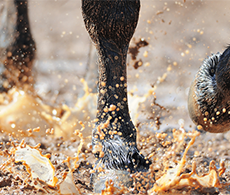
How to give your horse the best care in winter
The cold and wet winter months are always a challenge for horse owners. Not only does mud, driving rain and freezing temperatures suck the joy out of trips to the yard, but they can cause health issues, too. The good news is that with a little preparation and practical advice, you can protect your horse in the worst of winters.
Dealing with mud
“Horses didn’t evolve to cope with mud,” says Petplan Equine veterinary expert Gil Riley. “In the wild, they’d habitually move to drier, grassed areas to escape wet conditions underfoot. An outdoor life is, on balance, a healthier option so let your horse spend time in the field during the winter – but take measures to limit their exposure to mud and protect their lower legs.”
Field gateways have the highest amount of foot traffic and can become mud hot spots. “The soil becomes compressed, inhibiting drainage, so there’s potential for the gateway to turn into a mud bath,” explains Gil. “To improve footing, dig the whole area out before laying down a membrane and a thick layer of limestone hardcore on top. Once rolled, this will protect your horses’ feet from damage.”
This method won’t be possible for everyone, but other solutions include moving the gateway to a higher, dryer area or creating small, moveable paddocks with temporary fencing, which may be an option. Depending on your situation, you can also use mud mats to good effect.
“Effective drainage will limit mud production,” says Gil, who advises keeping drains and trenches clear, and diverting water run-off from roofs. “Picking up droppings can also reduce infection risk and improve pasture quality.”
Mud fever in horses
The main problem is that liquid mud underfoot can leave lower legs at risk from mud fever, which is a skin condition caused by bacteria that live in the soil.
“When legs are constantly wet, the oily layer of the skin that offers protection against bacterial infection is undermined,” explains Gil. “Germs can then penetrate the skin, causing soreness and inflammation. Cleaning muddy legs with tepid water is best, as a dry brush with stiff bristles could scratch the skin and allow bacterial access. Once they’re clean, towel the legs dry.”
Gil continues: “Applying turnout boots or wraps, or a coating of barrier cream before your horse goes out, can help keep infections at bay. Legs without heavy feather can be easier to keep clean and will dry faster, so consider clipping or trimming the lower limbs.”
A quick daily leg check should help nip any infections in the bud. “If mud fever does take hold, bathe the skin gently in warm, diluted disinfectant before patting it dry and apply a bacterial cream supplied by your vet,” says Gil, who advises wearing gloves to prevent infection spreading and stresses that scabs shouldn’t be picked. “In more severe cases, your vet may prescribe antibiotics,” adds Gil.
Winter hoof care
Standing in a quagmire can also soften hooves, allowing entry to mud-borne bacteria.
“The white line, which is the junction between the hoof wall and the horn of the sole, is a weak spot,” says Gil, explaining that this narrow band is softer than the tough horn. “Once softened, the white line is more vulnerable to penetration by bacteria. This can result in pus in the foot, a painful condition that can leave a horse unable to bear weight on that leg. The problem is usually straightforward for a farrier, with diligent paring of the hoof sole to release the pus.”
Softened hooves are also more likely to lose shoes. “A suction effect in deeper mud, or sliding to an abrupt halt, can pull a shoe clean off,” says Gil. “Partial loss, where the shoe shifts position on the hoof, can be more problematic as your horse can then step on one of the nails or clips and get a puncture wound. Regular visits from a qualified farrier will help keep hooves in trim and give shoes maximum staying power.”
Keeping warm – but not too warm
Helping your horse retain heat in the winter will help him or her conserve energy. It can be easy to forget, however, that horses cope outside better than we do and over-rugging can cause you problems, too.
Working out what rug to put on your horse will keep your horse comfortable. If you over-rug your horse, not only will they be too warm, but they’ll carry a lot of extra and unnecessary weight around, which will waste energy and be uncomfortable.
Investing in a couple of good turnout rugs in varying weights – or perhaps one that has compatible liners, so that you can easily adjust the layers – will help see you through the cold and wet weather.
When it comes to stabling, don’t forget that although your horse has more protection from the wind and rain, he’s unable to move around to get warm, so you’ll need to take this into consideration when you’re selecting his rug.
All horses will cope differently in the winter. Whether your horse is clipped, has access to shelter and their age, diet and general health and body condition will all be factors in determining how warm they are and what rugs they’d benefit from.


